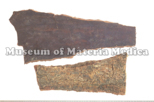Eucommia Bark

|
TMPW No.:10848 |
| Synonym | |
| Latin name | Eucommiae Cortex |
| Botanical source: Family name | Eucommiaceae |
| Botanical source: Plant name | Eucommia ulmoides Oliver (IPNI:554475-1) |
| Part used | Bark |
| Empirical criteria for quality selection | Good one has thick and moist bark. It produces lots of silver filiform threads when it is folded crosswise and stretched. (TN) |
| Constituents | Other aliphatic and related compounds: Eucommiol; 1-Deoxyeucommiol (leaf) Monoterpenoids: iridoids: Aucubin, Harpagide acetate, Ulmoside (=Aucubigenin-1-β-isomaltose), Geniposide, Geniposidic acid Lignans & Neolignans: d-Pinoresinol di-O-β-D-glucopyranoside, Liriodendrin, d-Pinoresinol O-β-D-glucopyranoside, d-Medioresinol di-O-β-D-glucopyranoside |
| Pharmacological effects | Parasympathomimetic action (water extract). |
| Indications | As a tonic, painkiller and antihypertensive, it is applied to deficiency of the kidney, pain of the knee and low back, back problem of pregnant women, weakness of legs, threatened abortion and hypertention. |
| Diseases | Heaviness and powerlessness in lumber and knee, Lower back pain, Impotence, Frequent urination, Irregular vaginal bleeding, Habitual abortion, Threatened abortion, Hypertension |
| Formulas | ishoho , kamishimotsuto , daibofuto |
| Meridian tropism | Liver, Kidney |
| Property | Warm |
| Flavor | Sweet, Slightly acrid/pungent |
| Classification in "Shen-non Ben-cao Jing" | Superior |
| TCM: Classification | Tonics |
| TCM: Medicinal effects | To tonify the liver and the kidney, to strengten the tendons and bones, and to prevent miscarriage.: For deficiency condition of the kidney marked by lumbago and lack of strength, threatened abortion, and hypertension. |
| Remarks | Listed in the Japanese Pharmacopoeia 18th ed. |
| References | TN: T. Namba & Y. Tsuda ed., Outline of Pharmacognosy, a Textbook, 3rd ed., Nankodo Co., Ltd., Tokyo, 1998. |
